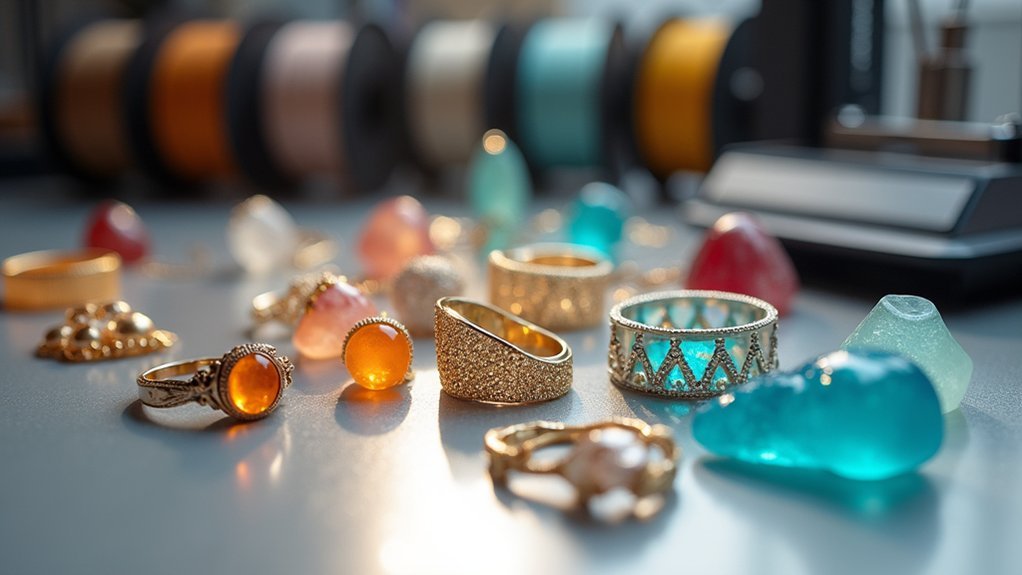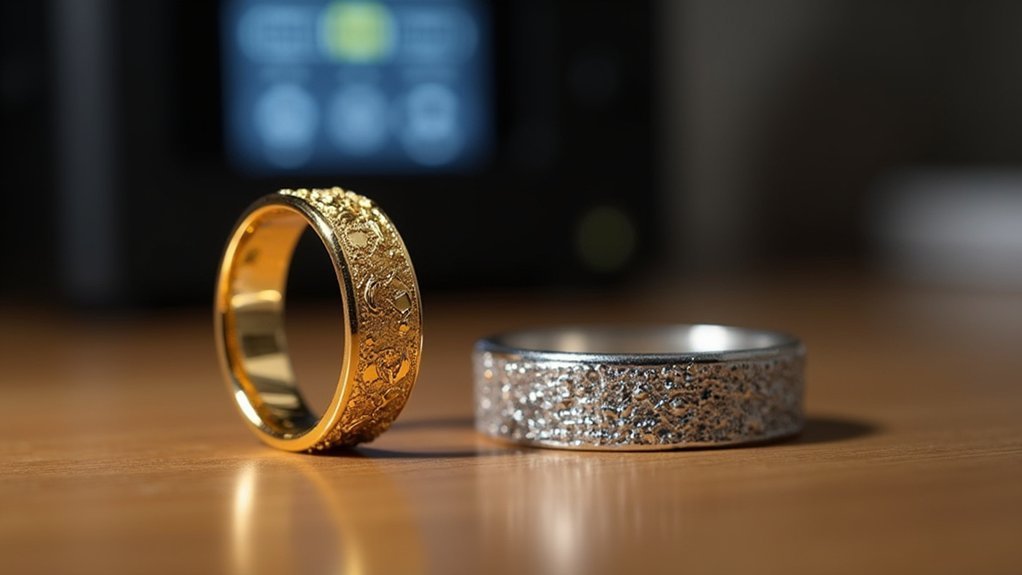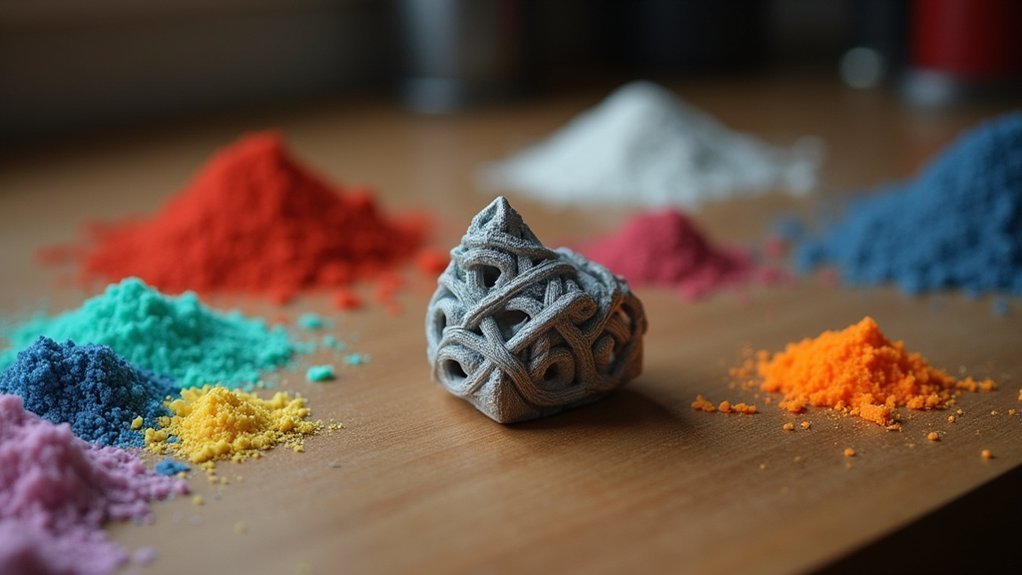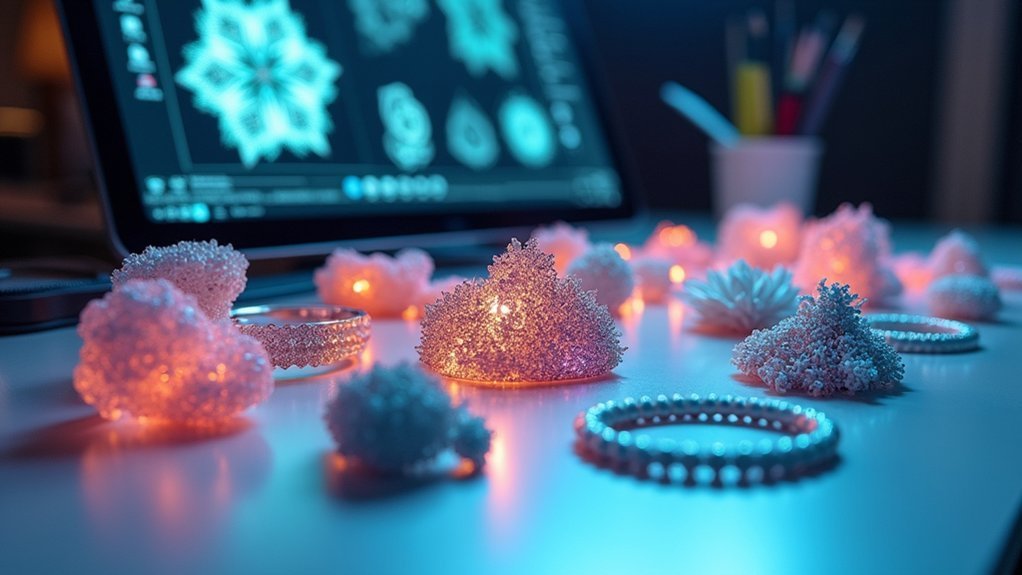3D jewelry printing costs vary dramatically because you’re dealing with multiple expensive variables that compound quickly. Material choice drives the biggest price swings—castable resins start at $50 per kilogram while precious metals reflect market rates. Design complexity requires support structures that add 20-30% to material costs, plus high-resolution printers for intricate details demand substantial investment. Technology choice, volume scale, geographic location, and extensive post-processing requirements all multiply your expenses, explaining why costs range from under $50 to thousands per piece depending on your specific needs.
Material Selection Impact on Jewelry Printing Expenses

When you’re planning a 3D jewelry printing project, your material choice becomes the primary cost driver that’ll shape your entire budget.
Material selection directly affects printing costs, with castable resins starting around $50 per kilogram while premium options exceed $100. If you’re working with precious metals like gold or platinum, you’ll face market prices reflecting material purity levels.
Material costs vary dramatically in 3D jewelry printing, from basic $50 castable resins to premium options exceeding $100 per kilogram.
For cost-effective prototyping, nylon offers affordability at approximately $50 per kilogram before shifting to final materials. Quality control becomes essential since higher-grade materials guarantee products are durable enough for long-term wear.
Innovations in material science, particularly low-ash content resins, improve casting fidelity and reduce post-processing expenses, ultimately impacting your total production costs.
Design Complexity and Its Effect on Production Costs
When you’re designing jewelry for 3D printing, the complexity of your patterns directly drives up production costs.
Intricate details require high-resolution printing technology and extended processing time, which means you’ll pay more for both equipment operation and labor.
Additionally, complex geometries force you to use support structures during printing, increasing your material consumption and adding post-processing steps that further inflate expenses.
Intricate Details Increase Costs
Every delicate filigree pattern, miniature engraving, and interlocking chain link you add to your jewelry design directly drives up production costs.
When you’re creating intricate details, you’ll need advanced printing techniques and high-resolution equipment that’s expensive to operate. Your complex jewelry designs require additional support structures during printing, increasing material usage and extending post-processing time considerably.
You’ll also face higher expenses when your detailed pieces demand specialized materials like castable resins or premium metals. These materials cost notably more than standard options used for simpler designs.
Additionally, you’ll invest more time in iterative design processes to perfect every tiny element. Each revision cycle adds labor costs and extends your production timeline, making intricate jewelry substantially more expensive than basic designs.
Support Structure Requirements
Because support structures act as temporary scaffolding during your 3D printing process, they’re essential for preventing collapse in complex jewelry designs with overhangs, bridges, and undercuts.
The design complexity of your piece directly determines how much support you’ll need, which greatly impacts both material usage and production time.
When you’re creating intricate designs with extensive undercuts, expect support structures to add 20-30% to your total material cost.
You’ll also face increased post-processing expenses since removing these supports requires additional labor and time.
Smart design planning can minimize these costs.
3D Printing Technology Choices for Precious Metal Work

While selecting the right 3D printing technology determines your project’s success and budget, you’ll find that each method brings distinct advantages and cost implications for precious metal jewelry.
| Technology | Best For | Cost Impact |
|---|---|---|
| Stereolithography (SLA) | Detailed wax models for casting | Lower material costs, requires casting |
| Selective Laser Sintering (SLS) | Direct metal printing | Higher metal powders costs |
| Direct Metal Printing | Complex geometries | Expensive machinery, high volume savings |
Your choice between SLA and SLS greatly affects your precious metal work expenses. SLA excels at creating intricate designs in wax for lost-wax casting, while SLS directly processes metal powders. The cost of metal printing escalates with precious materials like gold or platinum. Direct metal technologies demand substantial upfront investments but become economical with higher production volume. Post-processing requirements further influence your jewelry industry costs.
Volume and Scale Considerations in Jewelry Manufacturing
You’ll notice dramatic cost differences when comparing single-piece orders to batch production runs in 3D jewelry printing.
Your per-unit expenses drop considerably as you increase volume because setup costs, machine time, and material waste get distributed across more pieces.
Understanding these scale economics helps you make smarter decisions about whether to print one custom ring or produce an entire collection at once.
Single Vs Batch Production
Production volume dramatically affects your 3D jewelry printing costs, with single pieces costing considerably more per unit than batch orders.
Single production runs spread setup expenses across fewer items, inflating your cost per piece markedly. You’ll pay premium prices because material costs and processing time can’t be distributed efficiently.
Batch production leverages economies of scale, reducing your overall pricing through shared resources and bulk material purchases.
However, intricate designs may limit how many pieces you can produce simultaneously, affecting potential savings. High-volume orders reveal additional discounts through bulk material sourcing and streamlined workflows.
Post-processing requirements also influence costs differently between approaches.
Batch processes typically optimize finishing steps like polishing across multiple pieces, maximizing efficiency and minimizing your per-unit expenses compared to individual processing.
Scale Economics Impact
Because fixed costs remain constant regardless of production size, manufacturing larger quantities of 3D printed jewelry greatly reduces your per-unit expenses.
Scale economics considerably impact the cost of 3D printing by spreading initial investments across higher production volumes. When you implement batch production techniques, you’ll optimize material usage while minimizing waste, directly lowering your overall cost per unit.
Industrial-grade printers become more cost-effective as operational expenses decrease with increased output. High-volume production enables bulk purchasing of materials, securing substantial discounts that further reduce manufacturing costs.
You’ll achieve faster turnaround times and improved efficiency with technologies like SLA and SLS at scale. Though initial equipment investments seem substantial, you’ll recoup costs quickly through economies of scale, making large-scale jewelry production increasingly profitable.
Post-Processing Requirements and Associated Expenses

While 3D printing creates the basic structure of your jewelry piece, the real magic happens during post-processing—and this is where costs can quickly escalate.
Your finishing work requirements directly correlate with complexity, as intricate designs demand extensive removal of support structures and detailed polishing.
The material used greatly impacts post-processing expenses:
- Resin prints require UV curing and careful cleaning with specialized solvents
- Metal prints need sintering processes and professional polishing equipment
- Support structure removal adds substantial labor costs to your production timeline
- Surface finishing demands skilled technicians and high-end tools for best results
Your production expenses increase proportionally with desired visual appeal and durability.
Professional-grade post-processing enhances market value but requires specialized equipment and expertise, making labor costs a substantial portion of your final pricing structure.
In-House Vs Outsourced Jewelry Printing Cost Analysis
When choosing between in-house and outsourced jewelry printing, you’ll face a critical decision that greatly impacts your budget and operational flexibility.
In-house printing requires substantial upfront costs, ranging from $5,000 for basic systems to over $50,000 for high-end equipment. You’ll also handle ongoing maintenance expenses, material costs, and skilled labor requirements.
However, you’ll gain complete design control and enable rapid iterations without external delays.
Outsourcing to service bureaus offers financial flexibility through pay-as-you-go models, making it ideal for low-volume production runs.
Service bureaus leverage economies of scale, reducing per-part costs considerably.
While outsourcing eliminates equipment investments and maintenance headaches, you’ll sacrifice immediate access and face longer lead times that can slow your design process.
Equipment Investment and Operational Overhead Factors
Your decision between in-house and outsourced printing fundamentally depends on understanding the true cost of equipment investment ownership and ongoing operational overhead expenses.
3D printing equipment costs vary dramatically, from $5,000 for basic FFF printers to over $50,000 for professional SLA systems.
Your operational overhead extends beyond initial purchase:
- Material costs – Castable resins start at $50 per kilogram, while high-performance metals exceed $100 per kilogram.
- Skilled personnel – You’ll need trained operators for sophisticated equipment operation.
- Maintenance – Regular servicing and repairs add ongoing expenses.
- Post-processing – Polishing and detailing increase labor costs considerably.
These factors combine to create substantial recurring expenses that directly impact your production viability and profitability in jewelry manufacturing.
Geographic Location and Market Pricing Variations
Geographic factors create substantial price variations that can dramatically affect your 3D jewelry printing costs depending on where you source services. Your geographic location directly impacts pricing through local labor rates, material availability, and operational expenses.
Major cities typically charge premium rates due to higher overhead costs, while regions with lower expenses offer more competitive pricing for custom jewelry production.
Market demand considerably influences your costs too. High-demand areas with limited service providers drive prices up, whereas competitive markets keep rates affordable.
When sourcing internationally, you’ll encounter additional pricing variations due to currency fluctuations and regional cost differences.
Competition levels in your area also affect pricing—more providers typically mean better rates and service options for your jewelry printing needs.
Quality Standards and Their Influence on Final Pricing
Quality standards directly determine how much you’ll pay for 3D jewelry printing, as higher precision requirements exponentially increase production costs.
When you’re creating intricate designs, you’ll need high-resolution printers capable of 25-micron precision, which greatly raises equipment expenses.
Four key factors drive quality-related costs:
- Advanced printing equipment – High-resolution printers demand substantial investment
- Premium materials used – Castable resins and precious metals cost more than basic alternatives
- Extensive post-processing – Polishing and cleaning operations add labor expenses
- Industry compliance – Durability and safety testing require additional certification costs
The materials used for your final piece directly impact pricing, with high-performance options commanding premium rates.
Post-processing operations guarantee professional finishes but increase overall costs.
Quality standards aren’t negotiable for fine jewelry, making compliance essential despite expense increases.
Frequently Asked Questions
Why Does 3D Printing Cost so Much?
You’ll pay high 3D printing costs because specialty materials cost £100+ per kilogram, industrial printers reach £700,000, complex designs need more time and materials, plus you’ll face hidden post-processing and ongoing operating expenses.
Is 3D Printed Jewelry Profitable?
You’ll find 3D printed jewelry highly profitable due to low material costs, premium pricing for customization, reduced labor expenses, and quick production speeds that let you capitalize on trends without expensive tooling.
What Is the Biggest Problem With 3D Printing?
You’ll find material limitations are 3D printing’s biggest problem. You can’t use all materials with the technology, which restricts your design options and limits the applications you’re able to create successfully.
Why Are 3D Designs Faster to Use and More Cost Effective?
You’ll cut production time from days to hours through rapid prototyping, reduce material waste with multiple patterns per print, and eliminate expensive tooling costs while achieving intricate details automatically.





Leave a Reply